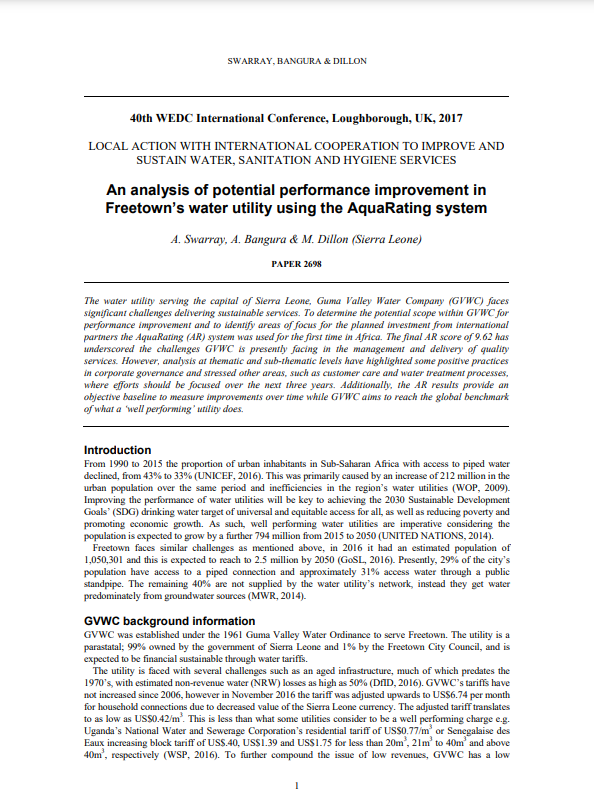
Local Action with International Cooperation to Improve and Sustain Water, Sanitation and Hygiene Services
The water utility serving the capital of Sierra Leone, Guma Valley Water Company (GVWC) faces significant challenges delivering sustainable services. To determine the potential scope within GVWC for performance improvement and to identify areas of focus for the planned investment from international partners the AquaRating (AR) system was used for the first time in Africa. The final AR score of 9.62 has underscored the challenges GVWC is presently facing in the management and delivery of quality services.
You can download a copy of it here.
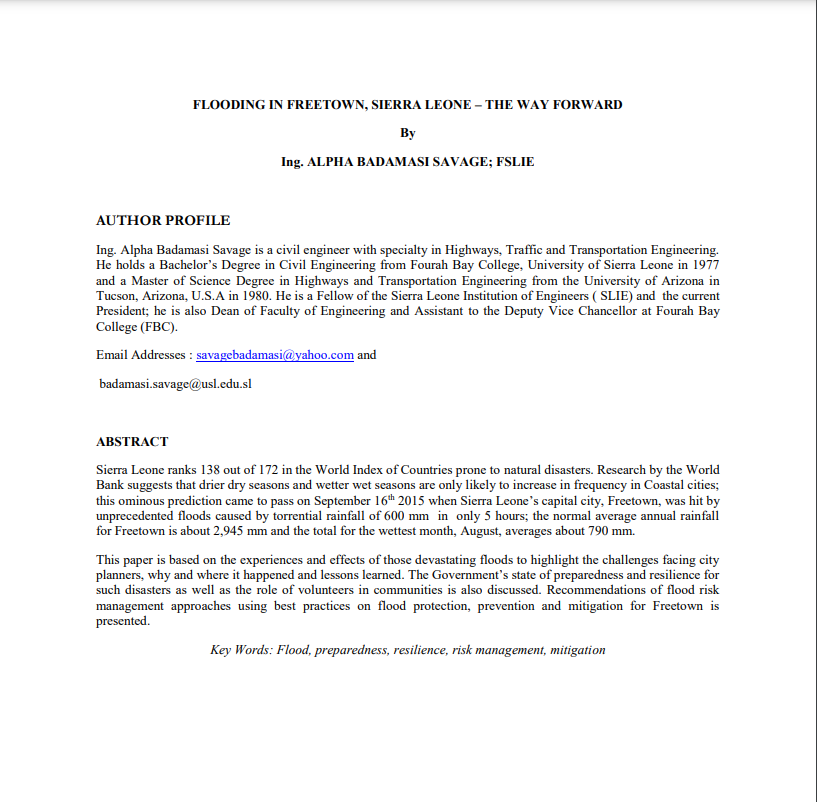
Flooding in Freetown, Sierra Leone – The way forward
Sierra Leone ranks 138 out of 172 in the World Index of Countries prone to natural disasters. Research by the World Bank suggests that drier dry seasons and wetter wet seasons are only likely to increase in frequency in Coastal cities; this ominous prediction came to pass on September 16th 2015 when Sierra Leone’s capital city, Freetown, was hit by unprecedented floods caused by torrential rainfall of 600 mm in only 5 hours; the normal average annual rainfall for Freetown is about 2,945 mm and the total for the wettest month, August, averages about 790 mm. This paper is based on the experiences and effects of those devastating floods to highlight the challenges facing city planners, why and where it happened and lessons learned. The Government’s state of preparedness and resilience for such disasters as well as the role of volunteers in communities is also discussed. Recommendations of flood risk management approaches using best practices on flood protection, prevention and mitigation for Freetown is presented.
You can download a copy of it here.
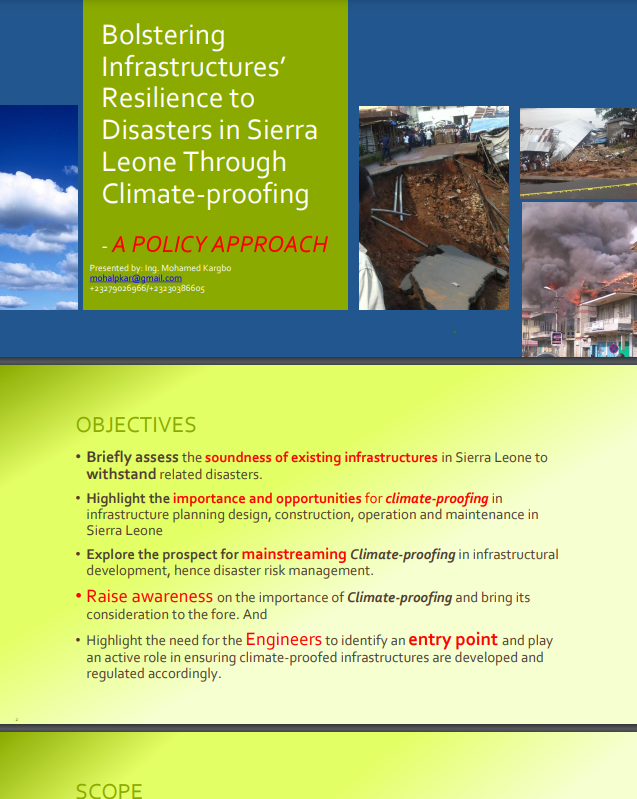
Bolstering Infrastructures’ Resilience to Disasters in Sierra Leone Through Climate proofings
A POLICY APPROACH Presented by:Ing . Mohamed Kargbo mohalpkar@gmail.com +23279026966/+23230386605 OBJECTIVES Briefly assess the soundness of existing infrastructures in Sierra Leone to withstand related disasters. Highlight the importance and opportunities for climate proofing in infrastructure planning design, construction, operation and maintenance in Sierra Leone Explore the prospect for mainstreaming Climate proofing in infrastructural development, hence disaster risk management. Raise awareness on the importance of Climate proofing and bring its consideration to the fore. And Highlight the need for the Engineers to identify an entry point and play an active role in ensuring climate proofed infrastructures are developed and regulated accordingly.
You can download a copy of it here.
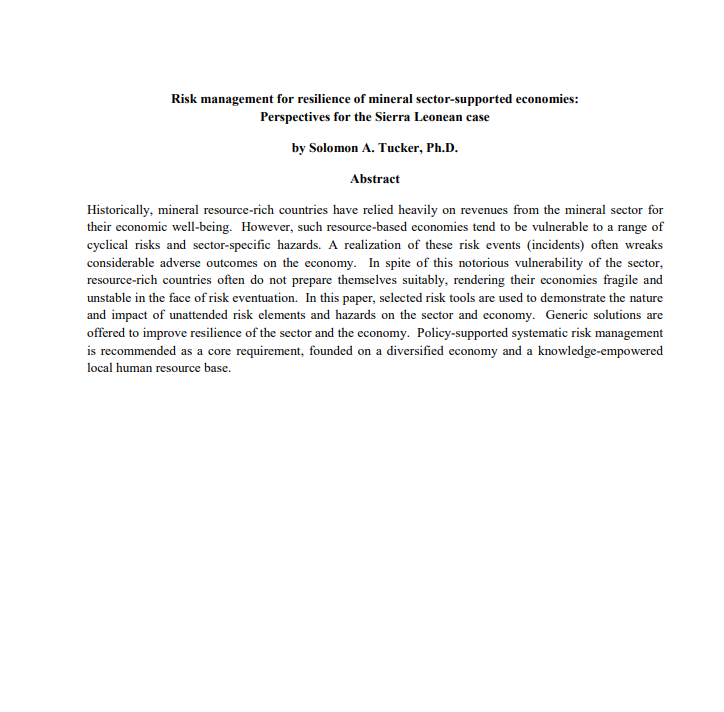
Risk management for resilience of mineral sector-supported economies
Risk management for resilience of mineral sector-supported economies:Perspectives for the Sierra Leonean case by Solomon A. Tucker, Ph.D. Historically, mineral resource-rich countries have relied heavily on revenues from the mineral sector for their economic well-being. However, such resource-based economies tend to be vulnerable to a range of cyclical risks and sector-specific hazards. A realization of these risk events (incidents) often wreaks considerable adverse outcomes on the economy. In spite of this notorious vulnerability of the sector, resource-rich countries often do not prepare themselves suitably, rendering their economies fragile and unstable in the face of risk eventuation. In this paper, selected risk tools are used to demonstrate the nature and impact of unattended risk elements and hazards on the sector and economy. Generic solutions are offered to improve resilience of the sector and the economy. Policy-supported systematic risk management is recommended as a core requirement, founded on a diversified economy and a knowledge-empowered local human resource base.
You can download a copy of it here.
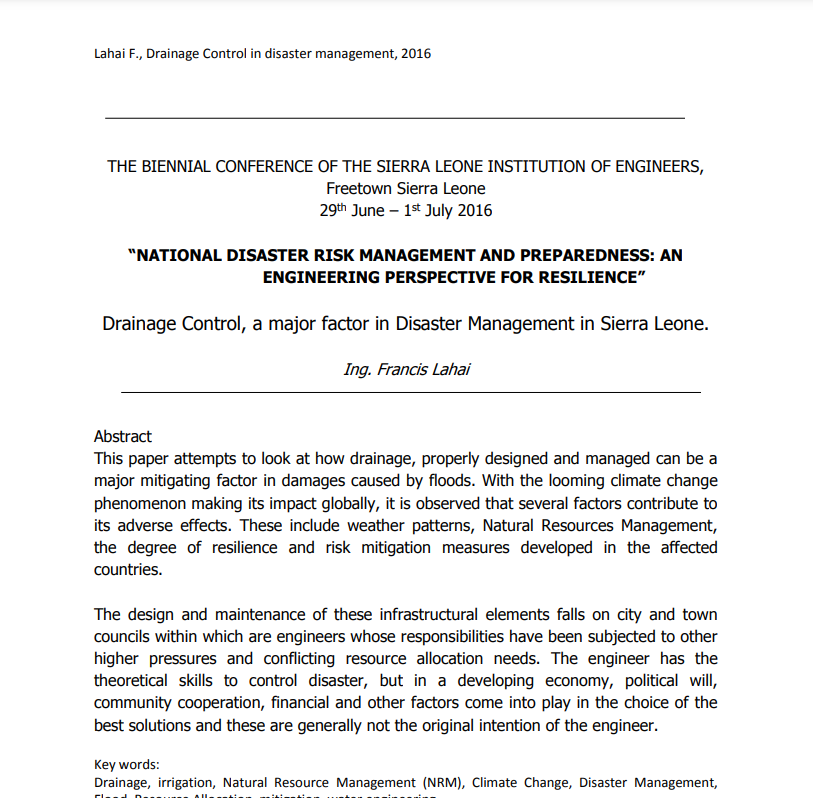
National Disaster Risk Management and Preparedness: An Engineering Perspective for Resilience
Drainage Control, a major factor in Disaster Management in Sierra Leone. Ing. Francis Lahai This paper attempts to look at how drainage, properly designed and managed can be a major mitigating factor in damages caused by floods. With the looming climate change phenomenon making its impact globally, it is observed that several factors contribute to its adverse effects. These include weather patterns, Natural Resources Management, the degree of resilience and risk mitigation measures developed in the affected countries. The design and maintenance of these infrastructural elements falls on city and town councils within which are engineers whose responsibilities have been subjected to other higher pressures and conflicting resource allocation needs. The engineer has the theoretical skills to control disaster, but in a developing economy, political will, community cooperation, financial and other factors come into play in the choice of the best solutions and these are generally not the original intention of the engineer. Key words: Drainage, irrigation, Natural Resource Management (NRM), Climate Change, Disaster Management, Flood, Resource Allocation, mitigation, water engineering.
You can download a copy of it here.
